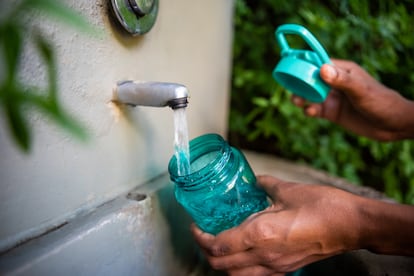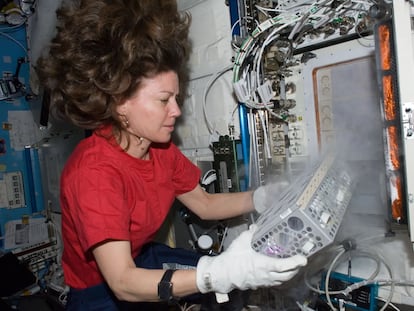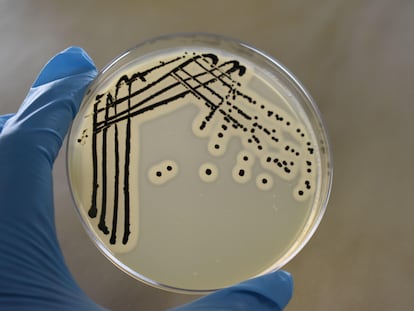How your water bottle could be a reservoir of bacteria and fungi
Reusable receptacles are more environmentally friendly than disposable ones, but without proper hygiene they can accumulate more microorganisms than a toilet

We are constantly encouraged to drink more water. The advice comes from doctors and is sold to us by influential celebrities, who appear on social networks with their colorful metal bottles that have become fashion accessories. Water consumption is no longer just about survival, it’s about smoother skin, a better digestion and more supple joints.
In parallel to the advice to drink more water come the warnings against plastic consumption for the health of the planet. In Spain, where 55 million containers are sold every day and only 36% are recycled, the obvious solution is a reusable bottle. But while these are a more environmentally friendly option, they can become a reservoir of bacteria and fungi when they are not cleaned properly and, with a bit of bad luck, could end up being a health risk.
This has been determined by a series of recent studies which looked at the accumulation of microorganisms in reusable water bottles. One of them, carried out by the International Association for Food Protection (IAFP), collected 90 bottles from university students in the U.S. and found that 70% of the containers exceeded the recommended limit of microorganism colonies for drinking water in some countries.
María del Mar Tomás, head of the Translational and Multidisciplinary Microbiology group at the Biomedical Research Institute of A Coruña, in Spain, explains that “normally, the bacteria that tend to accumulate in these types of bottles are coliforms, those found in the gastrointestinal tract.” In excrement, to put it bluntly. A study published in 2014 supports this claim. Scientists found that common, toxin-producing bacteria such as Escherichia coli and Staphylococcus aureus were present in samples of bottled water in reusable containers. Also present were some molds such as Aspergillus, which usually appear as white or yellow spots, and Penicillium, which manifest in blue or green tones.
More recently, a report by U.S.-based WaterFilterGuru found that some reusable water bottles had 40,000 times more bacteria than a toilet and five times more than a computer mouse. The numbers – while coming from a company that sells water filters – do not seem exaggerated, says Tomás.
And the fact is that when water remains in the bottle for several days, it can create a breeding ground in which mold spores that float in the air and bacteria that travel on hands settle and multiply. “If we don’t constantly change the water and even rinse the bottles daily, microorganisms can accumulate and form biofilms,” explains Tomás. A biofilm is a community of microbes that adhere to a surface, surrounded by a protective matrix that they themselves generate. If it appears, it will be more difficult to remove dirt and pathogens.
The type of bottle also plays a role. Studies indicate that the most hygienic material in terms of organic residues is glass, while plastic, whether hard or soft, and metal are more susceptible to bacteria accumulation. The same goes for those containers with straws or nozzles, which showed higher levels of contamination.
How to clean bottles?
The IAFP study found that 16% of users never cleaned their bottles. This is exactly what not to do. As Tomás explains: “What is recommended is to replace the water every day, wash the container with detergent and, after a certain period of time, disinfect it with water and a drop of bleach to prevent the formation of biofilms. If the container is dishwasher safe, it should ideally be disinfected in the dishwasher frequently. Another option is to soak the bottle for half an hour in equal parts water and vinegar, even adding baking soda to create effervescence and clean it more thoroughly. It is important to remove all movable parts of the bottle, such as straws and valves, where mold and mildew commonly lodge, and let the container dry before reusing it.
Drinking from a bottle contaminated with microbial colonies, which in the most extreme cases can give off an unpleasant odor and taste, does not necessarily represent a health problem. Most mold species are quite harmless and our immune systems if we’re healthy are quite capable of dealing with them. The same is true of the bacteria, although the gastrointestinal problems they cause are more common. Tomás warns that people with immune problems and allergies should be more alert and particularly careful with hygiene.
“For microorganisms in the water to cause a pathology, they have to be present in a very high concentrations, so we shouldn’t be alarmist. To avoid scares, it is enough to wash the containers regularly,” says Tomás. And if thorough cleaning is not enough to remove the most obvious dirt, it may be time to change bottles.
Sign up for our weekly newsletter to get more English-language news coverage from EL PAÍS USA Edition
Tu suscripción se está usando en otro dispositivo
¿Quieres añadir otro usuario a tu suscripción?
Si continúas leyendo en este dispositivo, no se podrá leer en el otro.
FlechaTu suscripción se está usando en otro dispositivo y solo puedes acceder a EL PAÍS desde un dispositivo a la vez.
Si quieres compartir tu cuenta, cambia tu suscripción a la modalidad Premium, así podrás añadir otro usuario. Cada uno accederá con su propia cuenta de email, lo que os permitirá personalizar vuestra experiencia en EL PAÍS.
¿Tienes una suscripción de empresa? Accede aquí para contratar más cuentas.
En el caso de no saber quién está usando tu cuenta, te recomendamos cambiar tu contraseña aquí.
Si decides continuar compartiendo tu cuenta, este mensaje se mostrará en tu dispositivo y en el de la otra persona que está usando tu cuenta de forma indefinida, afectando a tu experiencia de lectura. Puedes consultar aquí los términos y condiciones de la suscripción digital.
More information
Archived In
Últimas noticias
ChatGPT fails the test: This is how it endangers the lives of minors
The late consecration of women artists in their 90s
The Florida Keys tourist paradise is besieged by immigration agents: ‘We’ve never seen anything like this’
The latest scam on WhatsApp behind the legal dream: using immigration status as bait
Most viewed
- Families demand repatriation of bodies of Colombians who died in Ukraine: ‘This war is a slaughterhouse for foreigners’
- The low-cost creative revolution: How technology is making art accessible to everyone
- Liset Menéndez de la Prida, neuroscientist: ‘It’s not normal to constantly seek pleasure; it’s important to be bored, to be calm’
- Christian Louboutin: ‘Young people don’t want to be like their parents. And if their parents wear sneakers, they’re going to look for something else’
- ‘El Limones’ and the growing union disguise of Mexican organized crime











































